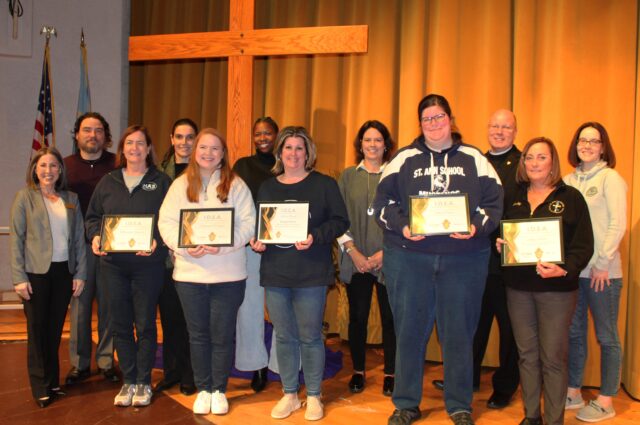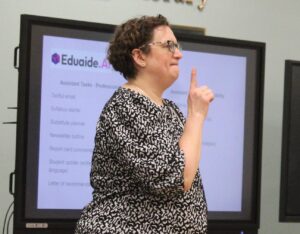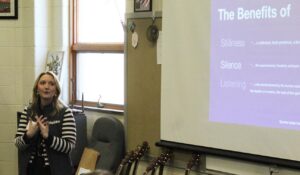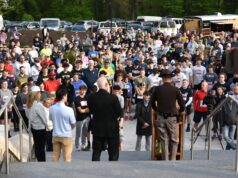
MILLTOWN — Teachers and administrators from Catholic schools across the Diocese of Wilmington gathered March 11 at Saint Mark’s High School to hear about technology that is working its way into the classroom: artificial intelligence.
John Sowash, a former educator and administrator who now leads a firm that helps teachers and students manage and use technology, delivered the keynote address. Afterward, breakout sessions were held addressing more than a dozen topics, including using artificial intelligence to support adolescent learners; practical applications of AI in the classroom; and technology tips and tricks for the art room.
Another presentation drew a group to the library, where Inger Cierniak talked about “The Teacher’s AI Genie in a Bottle.” Cierniak, the director of technology and computer science teacher at St. Elizabeth School, cycled through a bunch of topics related to how teachers could use artificial intelligence in the classroom.
The teachers said keeping students engaged is one of their challenges, and Cierniak told them that the “genie” — artificial intelligence — “has something on that.” Using ChatGPT, one of the leading AI systems, she created a text adventure game that took students on a tour of ancient Greece using a few prompts.
“If you’re a student, would you be more interested in this or reading 10 paragraphs in your textbook?” Cierniak asked.

Teachers need to remember a list of things when using AI to help with their classroom work. Those factors are represented by the acronym “prompt”: purpose, role, organization, modeling, parameters and tweak.
Those will help answer questions about what is being taught, or the purpose. For role, the teacher is giving AI a “specific hat to wear,” Cierniak said.
“You want to be very specific about the context” she said.
Organization means logical and clear structuring. Parameters includes items such as length, format, reading level, the number of questions and conditions for completion, among other things. Finally, tweaking means proofreading and editing AI’s result.
Artificial intelligence can also be used to help with classroom-related tasks that teachers must do, Cierniak continued. Some programs can write emails to parents, generate comments for report cards, and create letters of recommendation.
Another session addressed using artificial intelligence in a religious context. Annie Foster, who works with Hallow, one of the top prayer apps available online, gave a presentation titled “Tech Meets Tradition: Using Technology to Help Students Foster a Daily Prayer Life.”

Hallow is one of several Catholic and Christian prayer apps available for download. Foster said Hallow has content available for use in and out of the classroom.
“You never know what you ought to learn or what the Lord might need to tell you,” she said.
Despite the dangers possible with technology in the classroom, Foster told the teachers that it can be very beneficial. She used the late Fred Rogers as an example. Long before he started “Mister Rogers’ Neighborhood,” he worked in the television industry. He got into television, he once said, because he hated it and “thought there’s some way of using this fabulous instrument to nurture those who would watch and listen,” he once told CNN.
It is important to reach students at a young age, Foster said, because the average age of disengagement from the Catholic faith is 13. The founders of Hallow had fallen away from their faith as well.
Each of the sessions available on that particular app run from one to 60 minutes. They include vocal prayer, meditation and contemplative prayer. Hallow’s meditative prayer is designed to get people to participate, she said.
“If there’s one thing we want students to get out of Hallow, it’s the knowledge that their heavenly father loves them,” Foster said.
At the end of the event, five teachers were recognized for inspiring and educating students with the diocese’s first “Innovate. Develop. Educate. Award.” Four runners-up received $500, while the winner was awarded $1,500 and a prize package that included a trip to a spa and an overnight stay at an area hotel. The award was sponsored by the Kenny Family Foundation, which has long supported Catholic education in the Diocese of Wilmington. Chris Kenny was on hand to present the awards. His father, Bernie Kenny, the owner and operator of six Shop Rite grocery stores in Delaware and founder of the foundation, died in December.
The winner was Amy Platt of St. John the Beloved School. The runners-up were Rita Crowley of St. Ann School, Margaret Gugerty of Holy Angels School, Kathleen O’Connell of Padua Academy and Karen Banta of St. Peter Cathedral School.






